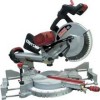Craftsman 21221 Operation Manual - Page 95
A Dado Fig. Oo
 |
View all Craftsman 21221 manuals
Add to My Manuals
Save this manual to your list of manuals |
Page 95 highlights
CUTTING BOWED MATERIAL (FIG. NN) WARNING I To avoid injury from materials being thrown, always unplug the saw to avoid accidental starting and remove small pieces of material from the table cavity. The table insert may be removed for this purpose, but always reattach table insert prior to performing a cutting operation. A bowed workpiece must be positioned against the fence and secured with a clamping device as shown before cutting. Do not position workpiece incorrectly or try to cut the workpiece without the support of the fence. This will cause the blade to bind and could result in personal injury. 3. While holding the upper arm in position, turn the stop knob (2) until it touches the stop plate (1). 4. Cut two parallel grooves as shown below. Fig. OO Fig. NN Cut these grooves with saw Use a chisel to cut out the middle TELESCOPING WORKPIECE SUPPORT & REPETITIVE CUTTING USING THE STOP PLATE (FIG. PP) Long pieces need extension table ROUGH CUTTING A DADO (FIG. OO) support. 1. Mark lines identifying the width 1. Loosen the knob (1) then slide the and depth of the desired cut on extension table to desired position the workpiece and position on the and tighten the knob. table so the inside tip of the blade 2. The stop plate is designed for use is positioned on the line. Use a during repetitive cutting. Only use hold down clamp to secure the one stop plate at a time. Rotate the workpiece. stop plate (3) to vertical position, 2. Lower the cutting head so the tip of and retighten the locking bolt. If the blade touches the top surface stop plate will not rotate, loosen the workpiece at the marked line. locking bolt (2) 1/4 turn. 39















